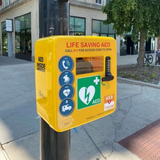Workplace Fire Safety Statistics - Don’t Get Caught Out!
After the Grenfell Tower tragedy in the summer of 2017, governing bodies across the UK have reinforced fire safety standards for landlords and property owners, in a bid to prevent such awful events from happening again. But it isn’t just landlords who are being put under the microscope, business owners must also take responsibility for their fire regulations in the workplace.
Between 2017 and 2018, England’s fire and rescue services attended around 565,000 incidents, an increase of 1% on the previous year, and 8% higher than the period between 2012 and 2013, which saw 521,000 incidents.
Fire related deaths are also on the rise, with the period between 2017 and 2018 seeing a rise of 27% in fatalities. Many of these incidents could have been avoided, were it for proper fire safety planning and preparation, or with the correct fire safety protocol in place.
Who is Responsible?
The Regulatory Reform (2005) states that the duty of fire safety protocol lies with the employer in the place of work. Therefore, the employer could be found responsible for cause of a fire if it happens on their premises and no steps had been taken to prevent the fire, or if there was no clear preparation or fire safety protocol in place for such an emergency.
If you are taking on a new premises, and the previous owner had full fire safety protocol in place, you are still personably responsible for fires on your premises, not the previous owner. It is therefore in you best interest to apply your own risk assessment. The risk assessment by the previous owner does not eliminate your need to put in place your own fire safety protocol.
What can I do?
Some steps you can take to avoid fire related incidents in the workplace include, identifying fire hazards on your premises, identifying any staff/employees that are at risk, evaluation or reduction of present risks, recording findings and planning ahead, including fire safety training for staff/employees, regularly reviewing and updating your fire safety policy.
What to Look Out For
The most common cause of accidental fires between 2017 and 2018 were cooking appliances. They accounted for around 50% of accidental fire ignitions during the year. If your workplace features a kitchen or canteen area, there could be unsuspected fire risks there. Ensure this is included on your risk assessment.
Smokers’ materials like lighters, cigarettes, cigars and pipes, were found to have caused 7% of accidental fires but were the cause of ignition in 20% of fatal fires. Ensure you include smoking areas and facilities smokers might use in your risk assessment.
Check Your Smoke Alarms
21% of fatal fires between 2017 and 2018 were in buildings with no fire alarms. Ensuring you have both fire and smoke alarms fitted to your premises is not only a legal requirement and a firm recommendation from the emergency services, it is a duty to yourself and your staff/employees.
If there are any further steps you can take to prevent what happened at Grenfell from happening again, be it fire safety equipment, training for staff or planning and protocol creation, you have a duty to take them.
Browse our range of fire safety equipment, risk assessment materials or any other products that may be useful. Let’s prevent fire related deaths together.
Recent Posts
-
Empowering Communities: The Lifesaving Impact of CPR on Restart a Heart Day
Every year, on and around October 16th, an important event takes place - Restart a Heart Day. This a …16th Oct 2023 -
Which home defibrillator?
80% of all out of hospital cardiac arrests occur at home. Defibrillators are often available in loca …4th Dec 2022 -
Which defibrillator should I buy?
There are many defibrillators available on the market and it can become overwhelming knowing which o …4th Nov 2022




